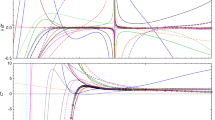Abstract:
A general phenomenological reaction-diffusion model for flow-induced phase transitions in complex fluids is presented. The model consists of an equation of motion for a nonconserved composition variable, coupled to a Newtonian stress relation for the reactant and product species. Multivalued reaction terms allow for different homogeneous phases to coexist with each other, resulting in banded composition and shear rate profiles. The one-dimensional equation of motion is evolved from a random initial state to its final steady state. We find that the system chooses banded states over homogeneous states, depending on the shape of the stress constitutive curve and the magnitude of the diffusion coefficient. Banding in the flow gradient direction under shear rate control is observed for shear-thinning transitions, while banding in the vorticity direction under stress control is observed for shear-thickening transitions.
Similar content being viewed by others
Author information
Authors and Affiliations
Additional information
Received 1 April 2001 and Received in final form 16 June 2001
Rights and permissions
About this article
Cite this article
Goveas, J., Olmsted, P. A minimal model for vorticity and gradient banding in complex fluids. Eur. Phys. J. E 6, 79–89 (2001). https://doi.org/10.1007/s101890170030
Issue Date:
DOI: https://doi.org/10.1007/s101890170030




